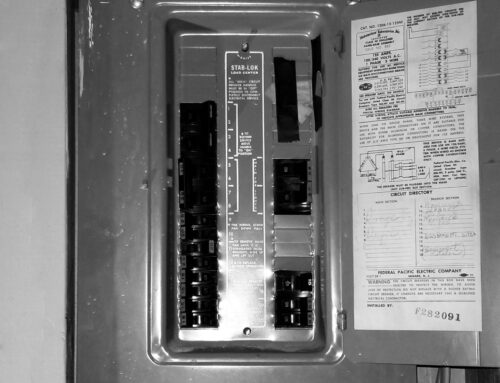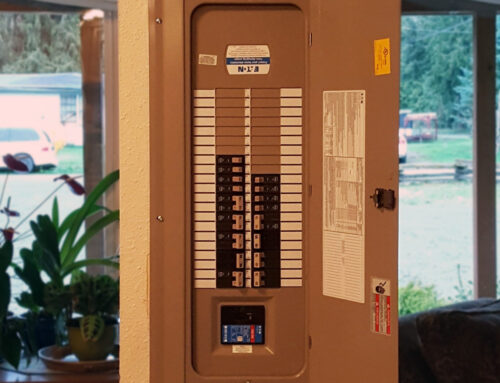(If you need a handy primer on circuit breakers and what they do, check out our post on Everything You Need to Know about Circuit Breakers!)
What happens when your home’s circuit breaker keeps tripping even after it’s been reset?
Though some homeowners don’t know much at all about their circuit breakers, many know how to at least reset a tripped breaker or replace a blown fuse. But if it’s becoming a common issue, it’s worth understanding the reasons why this might be happening.
So what can cause breakers to trip?
Overloaded Circuit
An overloaded circuit occurs when the electrical load has exceeded the circuit’s capacity, thus tripping the breaker. Common culprits are high-powered appliances such as space heaters, wall-unit air conditioners, and blow dryers; these can draw around half the power available for any given circuit.
Care must be given when using other devices on the same circuit as these appliances, otherwise you may trip the breaker over and over again. Space heaters, in particular, draw so much power that you may not be able to power much more on the same circuit.
Additionally, extension cords must NEVER be used with any high-powered appliances or as permanent home wiring, as they are typically not rated to accept as much power as wires within your walls.
If you find you’re unable to plug in necessary appliances where you want, you may need an electrician to take a look. We’ll be able to see how the circuit is being overloaded, and give you a price estimate for a dedicated circuit in a spot you can use safely.
Short Circuit
“Short circuit” is a term that gets misused quite often. A short circuit happens when an electrical circuit takes an unintended path (specifically, when a line-to-line or line-to-ground fault occurs). In homes, this often happens when a wire comes loose and touches another that it isn’t supposed to.
We see this with older home wiring that has been severely degraded, and could also be triggered by old equipment with similar wiring issues being plugged in. Sometimes, if a home is having new siding nailed on, a nail might go straight through a wire in the wall, causing a direct short.
If you find that your breaker keeps tripping right when you turn it on, you have a short circuit causing the problem. Short circuits can be dangerous, so make sure you have a professional diagnose the issue; they’ll be able to narrow down where the problem is, and run a new wire where the damaged wiring currently exists.
Ground Fault
A ground fault occurs when an energized conductor touches the ground conductor or metallic frame of an appliance. Standard thermal-magnetic circuit breakers do not detect ground faults, and will not protect against electric shock when a ground fault occurs; unlike with a short circuit, the breaker will not trip, and will continue to leak voltage to metallic equipment. This needs fixing as soon as possible to prevent accidental electrocution.
Breakers with GFCI protection, however, will trip when a ground fault occurs; if you have a GFCI breaker, this may be a possible cause. If your home still uses only a standard breaker, a GFCI breaker may need to be installed to detect a future ground fault and trip before anyone gets electrocuted.
Deteriorating Breaker
All electrical devices wear out eventually, and that includes circuit breakers. Although some breakers have lasted over half a century, they may not adequately protect the same as a newer one will. There are many mechanical components in a breaker, and over time the materials may not react appropriately. The mechanical spring that is activated when switching a breaker on and off sometimes fails to hold the breaker on whether it’s using power or not.
Schneider Electric is the manufacturer of QO and Homeline, two common brands of panels and breakers for homes. They expect their breakers to last an average of 30 years, but this is under optimal circumstances, annual exercising of the components, and many other conditions that can affect lifetime of the breaker. If your home’s breaker does not undergo regular maintenance, it may fail sooner.
Additionally, all older breakers are standard thermal-magnetic breakers or older GFCI breakers. Most newer breakers have additional protection, such as AFCI protection. Many breakers are made with a self-test function to continually check that its protection is still active. If the self-test says it can no longer provide protection, it will lock itself in the off position to make sure it can’t be mistaken for providing protection. This breaker will then need to be replaced with a new one.
My 15A breaker keeps tripping. Can I just change it out for a 20A?
You should never under any circumstances change out a breaker for one that trips at a higher value. Doing so may result in the wires taking on excessive energy and heat, which will burn away the insulation on the conductors and the overall cable. After a while, it will burn the wood it is up against, starting a fire. Electricians usually size the breaker to the wire size for most circuits, and they cannot be sized differently.
The only safe solution is to have an electrician come out to evaluate where power is needed, and how to run a new circuit from the electrical panel to safely power it.
If you need to replace your breaker, call Schwab Electric!
The right brand of breaker is needed per manufacturer requirements, which only allow certain breakers in your panel. Often, in older homes, people have added many of their own things in their panels and you can find four (or more) different brands of breakers. Breakers of other brands do not seat into the bus very well, and can result in loose connections starting a fire.
Making sure your breaker is for the correct amperage per the circuit is important, and it’s not something that can be answered over the phone. It must be seen in person, to make sure the circuits are sized appropriately to the wires or to the equipment it is handling. Schwab Electric has all the skills and experience to handle this safely—call us today!



